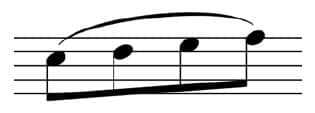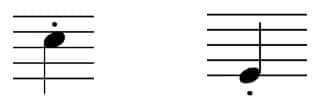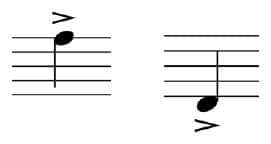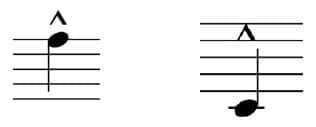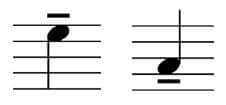Musicians are able to make notes sound in a variety of ways. Apart from loud and soft, notes can be played smoothly, detached, slightly accented, very accented and so on. In other words, musicians can articulate
notes in different ways.
Articulation refers to the musician’s specific technique when playing a note. But rather than writing instructions for how to breathe, press a key or bow a string for every different instrument, we add articulation marks
to the notes. These marks indicate how the notes should sound. The exact technical execution is then left up to the musician.
Legato
Legato
means that the notes should be played as smoothly and as connected as possible
. The idea is that there shouldn’t be a gap between the notes. For wind instruments (and voice), legato is achieved by singing two or more notes in one breath–the constant stream of air ensures that the sound is continuous from one note to the next. For bowed string instruments such as the violin, the notes are played in a single, continuous bow movement.
Legato is indicated in written music with a slur
–a line strung between note heads:
The slur over pairs of notes
The slur can also be strung over several notes. These 4 notes are played legato:
The slur over a group of four notes
The difference between the tie and the legato slur
This question comes up because the tie and the legato slur are practically the same symbol. To know whether the symbol is a tie or a legato sign is quite simple: ties occur between the same note at the same octave
(same exact pitch), while the legato slur occurs between two or more different notes.
The tie vs. the legato slur
For a wonderful example of legato in real music, look at Audio Example 26.1 in our companion course.
Staccato
Staccato
means that the notes are not connected but detached from each other. The musician achieves this effect by shortening the note, usually by about half its original duration.
The symbol for staccato is a dot with the note head. Similar to the legato slur, the staccato dot is written just close to the note head, no matter where the stem points.
For one of my favorite examples of staccato, look at Audio Example 26.2 in our companion course.
Staccatissimo
The word staccattissimo
is the Italian superlative of staccato, meaning that the notes will be detached and shortened even more than normal staccato
. The symbol for staccattissimo is this:
To see staccatissimo in action, have a look at Audio Example 26.3 in our companion course.
Marcato
The word marcato
is Italian for marked.
In music it indicates that a note is accented so that it’s louder than the surrounding notes.
The exact amount of emphasis a note is given depends a lot on the particular context and the performer’s musical decisions. However, we do have two typical kinds of marcato
signs for varying levels of emphasis.
The standard marcato is usually referred to simply as the accent
and it’s notated as a vertical wedge close to the note head.
The other is a horizontal wedge and it is known as marcato
itself, or martellato
–Italian for hammered. This sign indicates a stronger emphasis than the other accent sign.
The marcato
sign stays on top of the notes, no matter the direction of the stem.
For examples of marcato in real music, look at Audio Examples 26.4 and 26.5 in our companion course.
Tenuto
Probably owing to its long history of usage, the tenuto
mark is one of the least straightforward articulation marks in our entire system of musical notation. The word tenuto itself is Italian for held and because of this it’s often defined as an instruction to hold the note for all its duration (and nothing less). But its actual use by composers reveals that its interpretation depends on its context.
There are two common interpretations of the tenuto mark. Firstly, to give the note a slight accent
and secondly, to extend the note’s duration a bit more than its full written value
.
In other words, the tenuto mark indicates an emphasis of a note (or group of notes), either through a mild dynamic accent or through a little rhythmic prolongation.
An alternative to the tenuto marking is the word tenuto itself, usually abbreviated as ten
.
For examples of tenuto signs in real music, look at Audio Examples 26.6 and 26.7 in our companion course.
Portato
Portato
, also known as non-legato
,
is an interesting articulation in that it is somewhere in between staccato
and legato
. In portato, notes are connected and played smoothly (like in legato
) but they are also individually slightly pronounced. The effect is that the music moves along smoothly with a kind of gentle pulsation to each note.
The notation for portato combines the staccato dot with the legato slur:
Look at Audio Example 26.8 in our companion course for an example of portato.
Glissando
Glissando
is a slide from one note to another. When playing any two notes, the instrumentalist would normally move from one to the next avoiding getting any sound from any of the notes in-between. But in glissando those in-between notes are heard as passing through. The effect is a continuous run of adjacent pitches.
The symbol for the glissando is a line with the abbreviation gliss
.
on it. It can go in either direction, up or down:
The glissando effect is synonymous with the harp as it’s just natural to go through the strings rapidly. In the companion course you will find an example from the final movement of Ravel’s Ma Mère l'Oye Suite.
It features the harp quickly going up and down the strings in glissandos. The term gliss.
itself isn’t always written but the glissando is implied with the line going between note heads.
One of the most popular glissandos is the opening measure of Gershwin’s Rhapsody in Blue
. This is notated as a tuplet of seventeen fast notes in a single breath.
Look at Audio Examples 26.9 and 26.10 in our companion course for examples of glissando.


